Fintech
Alliance Advisors Issues White Paper on Climate Disclosure and Analysis for Corporations
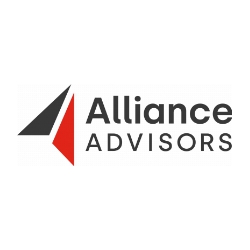
Investors Want More, Better Information
London, United Kingdom–(Newsfile Corp. – July 17, 2023) – Global investors recognize the investment risks and opportunities associated with climate change, and as a result, are seeking out more consistent, comparable, accurate, and high-quality information from companies about their exposure to and preparedness for climate-related impacts, according to a new white paper by Emmanuelle Palikuca titled: The Role of Climate Disclosure and Scenario Analyses for Companies, which is now available on the Alliance Advisors website: https://allianceadvisors.com/from-risk-to-resilience-the-role-of-climate-disclosure-and-scenario-analyses-for-companies.
Alliance Advisors is a global corporate advisory and shareholder advisory firm serving more than 1,000 clients.
In this research, done in collaboration with Steve Smykal, the founder and president of 1 World Sustainability, a U.S.-based consulting firm specializing in climate risk management and sustainability strategy, Palikuca and Smykal discuss the specifics of investor voting policies, engagement priorities, and emerging disclosure regulation around the globe.
Government regulation is driving climate action and corporate disclosures, as part of the ESG movement. There is a growing recognition of the financial risks and opportunities associated with sustainability. As recognition of the financial risks and opportunities of the impact associated with sustainability continues to evolve, there will be a tightening of ESG disclosures across the board to promote more standardized, widespread, and consistent access to climate related information, predicts Palikuca and Smykal, whose paper includes a snapshot of climate disclosure rules from six major global economies, including the USA, the EU and Hong Kong. Nearly all the emerging regulations are informed by the same source – the TCFD framework (Task Force on Climate-related Financial Disclosures.)
With investors’ focus on transition planning, climate scenario analyses play a key role in many of these regulations, notes Palikuca and Smykal.
Enhanced Risk Management
Climate reporting and disclosures can help companies identify and manage climate-related risks, such as extreme weather events, supply chain exposure, and regulatory changes. Each company has their own unique physical, transition, and liability risks that are becoming more prevalent, writes Palikuca and Smykal.
-
Physical Risk: 92% of the S&P 1200 will have at least one asset highly exposed to physical risks by the year 2050 under a high emissions scenario.
-
Transition Risk: Carbon economies could see a loss of $1.4 trillion in stranded fossil fuel assets.
-
Liability Risk: Several investigations and multi-million-dollar fines regarding ESG and greenwashing around the world have materialized in the last 18 months
By understanding and managing these risks, companies can avoid costly losses and improve their long-term resilience.
Climate-Related Shareholder Proposals
The 2022 proxy season saw record high numbers of environmental shareholder proposals, but declining levels of support from shareholders, says Palikuca.
“During the first half of 2023, we have seen this trend continue with lower support from investors across environmental proposals. Many of the climate-related shareholder proposals that have gone to a vote have fallen short of reaching a majority, receiving about 30-40% support,” she writes.
This shift is primarily due to shareholders applying greater scrutiny to the purpose or scope of proposals. Many institutional investors have introduced new engagement or stewardship policies and goals that outline their expectations for corporate climate disclosure and progress.
Although the policies vary, notes Palikuca and Smykal, they share a common need to identify climate risks and opportunities and their impact on the business, which can be done through a climate scenario analysis.
“In some cases, these proposals have failed even with proxy advisory firms such as Institutional Shareholder Services (ISS) and Glass Lewis recommending in favor of the proponent as shareholders apply greater scrutiny to the purpose or scope of proposals,” notes Palikuca, who prior to joining Alliance, was a Group Manager on the Sustainability Advisory team at ISS Corporate Solutions (ICS).
MEASURING PROGRESS
“Institutional Investors ultimately want to see and measure companies’ progress, so it is crucial that companies demonstrate they are moving in the right direction and will continue to evolve their approach over time,” writes Palikuca and Smykal.
Enhancing climate-related disclosure not only enables companies to comply with emerging regulations, but it can also enable companies to manage risks, unlock value, strengthen its reputation, and attract new capital, she adds.
“Inevitably, however, climate action warrants long-term planning, and while there is a lot expected of corporates around climate strategy and disclosure — the most important step is to get started, ” says Palikuca and Smykal.
5 Steps to Build Your Climate Strategy
To begin tackling climate change and disclosure requirements, companies can focus on a few key areas. For companies that are unsure of how to begin building their climate-related disclosure, Palikuca and Smykal recommend five steps for companies to get started.
-
Understand Climate related Requirements and Expectations
-
Conduct a Climate Scenario Analysis
-
Establish Governance and Oversight of Climate Risks
-
Enhance Climate Disclosure in Line with TCFD Recommendations
-
Engage Your Stakeholders
Even as companies transition toward net-zero emissions and mitigate their contributions to climate change, they will not be insulated from the global impacts of climate change. Conducting ongoing climate scenario analyses enable companies to continue monitoring the potential risks and opportunities their business and operations may face under a changing climate, says Palikuca and Smykal.
For more information, go to www.AllianceAdvisors.com.
Media Contact: Emmanuelle Palikuca: [email protected]

To view the source version of this press release, please visit https://www.newsfilecorp.com/release/173701
Fintech
How to identify authenticity in crypto influencer channels

Modern brands stake on influencer marketing, with 76% of users making a purchase after seeing a product on social media.The cryptocurrency industry is no exception to this trend. However, promoting crypto products through influencer marketing can be particularly challenging. Crypto influencers pose a significant risk to a brand’s reputation and ROI due to rampant scams. Approximately 80% of channels provide fake statistics, including followers counts and engagement metrics. Additionally, this niche is characterized by high CPMs, which can increase the risk of financial loss for brands.
In this article Nadia Bubennnikova, Head of agency Famesters, will explore the most important things to look for in crypto channels to find the perfect match for influencer marketing collaborations.
-
Comments
There are several levels related to this point.
LEVEL 1
Analyze approximately 10 of the channel’s latest videos, looking through the comments to ensure they are not purchased from dubious sources. For example, such comments as “Yes sir, great video!”; “Thanks!”; “Love you man!”; “Quality content”, and others most certainly are bot-generated and should be avoided.
Just to compare:
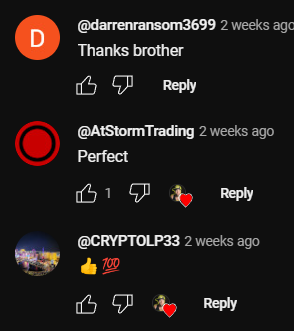
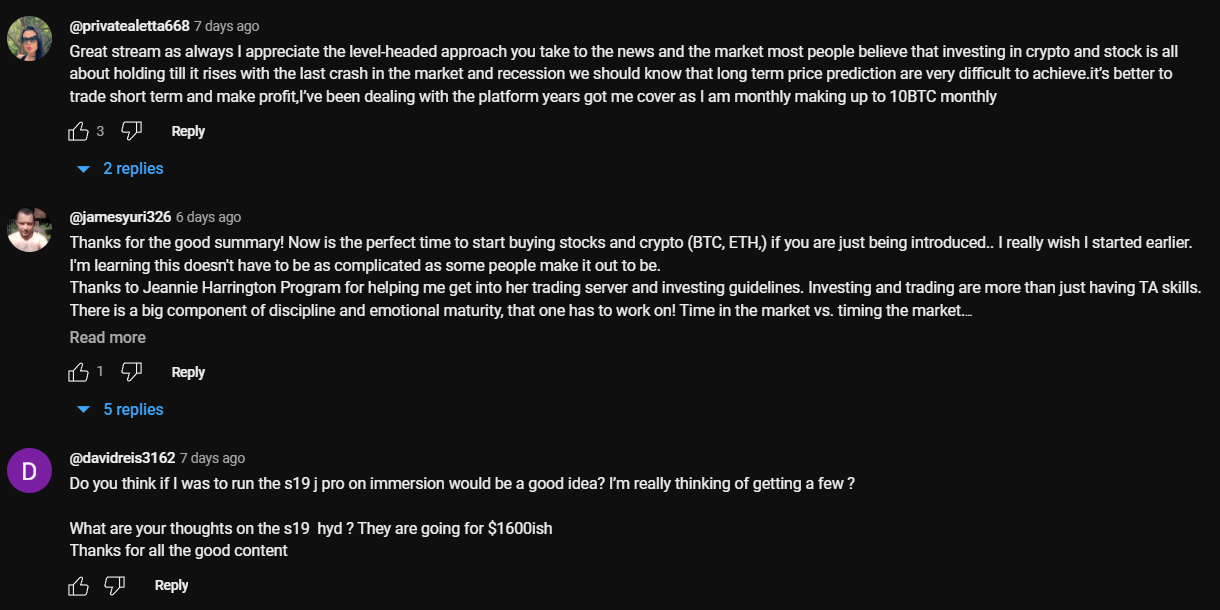
LEVEL 2
Don’t rush to conclude that you’ve discovered the perfect crypto channel just because you’ve come across some logical comments that align with the video’s topic. This may seem controversial, but it’s important to dive deeper. When you encounter a channel with logical comments, ensure that they are unique and not duplicated under the description box. Some creators are smarter than just buying comments from the first link that Google shows you when you search “buy YouTube comments”. They generate topics, provide multiple examples, or upload lists of examples, all produced by AI. You can either manually review the comments or use a script to parse all the YouTube comments into an Excel file. Then, add a formula to highlight any duplicates.

LEVEL 3
It is also a must to check the names of the profiles that leave the comments: most of the bot-generated comments are easy to track: they will all have the usernames made of random symbols and numbers, random first and last name combinations, “Habibi”, etc. No profile pictures on all comments is also a red flag.
LEVEL 4
Another important factor to consider when assessing comment authenticity is the posting date. If all the comments were posted on the same day, it’s likely that the traffic was purchased.
2. Average views number per video
This is indeed one of the key metrics to consider when selecting an influencer for collaboration, regardless of the product type. What specific factors should we focus on?
First & foremost: the views dynamics on the channel. The most desirable type of YouTube channel in terms of views is one that maintains stable viewership across all of its videos. This stability serves as proof of an active and loyal audience genuinely interested in the creator’s content, unlike channels where views vary significantly from one video to another.
Many unauthentic crypto channels not only buy YouTube comments but also invest in increasing video views to create the impression of stability. So, what exactly should we look at in terms of views? Firstly, calculate the average number of views based on the ten latest videos. Then, compare this figure to the views of the most recent videos posted within the past week. If you notice that these new videos have nearly the same number of views as those posted a month or two ago, it’s a clear red flag. Typically, a YouTube channel experiences lower views on new videos, with the number increasing organically each day as the audience engages with the content. If you see a video posted just three days ago already garnering 30k views, matching the total views of older videos, it’s a sign of fraudulent traffic purchased to create the illusion of view stability.
3. Influencer’s channel statistics
The primary statistics of interest are region and demographic split, and sometimes the device types of the viewers.
LEVEL 1
When reviewing the shared statistics, the first step is to request a video screencast instead of a simple screenshot. This is because it takes more time to organically edit a video than a screenshot, making it harder to manipulate the statistics. If the creator refuses, step two (if only screenshots are provided) is to download them and check the file’s properties on your computer. Look for details such as whether it was created with Adobe Photoshop or the color profile, typically Adobe RGB, to determine if the screenshot has been edited.
LEVEL 2
After confirming the authenticity of the stats screenshot, it’s crucial to analyze the data. For instance, if you’re examining a channel conducted in Spanish with all videos filmed in the same language, it would raise concerns to find a significant audience from countries like India or Turkey. This discrepancy, where the audience doesn’t align with regions known for speaking the language, is a red flag.
If we’re considering an English-language crypto channel, it typically suggests an international audience, as English’s global use for quality educational content on niche topics like crypto. However, certain considerations apply. For instance, if an English-speaking channel shows a significant percentage of Polish viewers (15% to 30%) without any mention of the Polish language, it could indicate fake followers and views. However, if the channel’s creator is Polish, occasionally posts videos in Polish alongside English, and receives Polish comments, it’s important not to rush to conclusions.
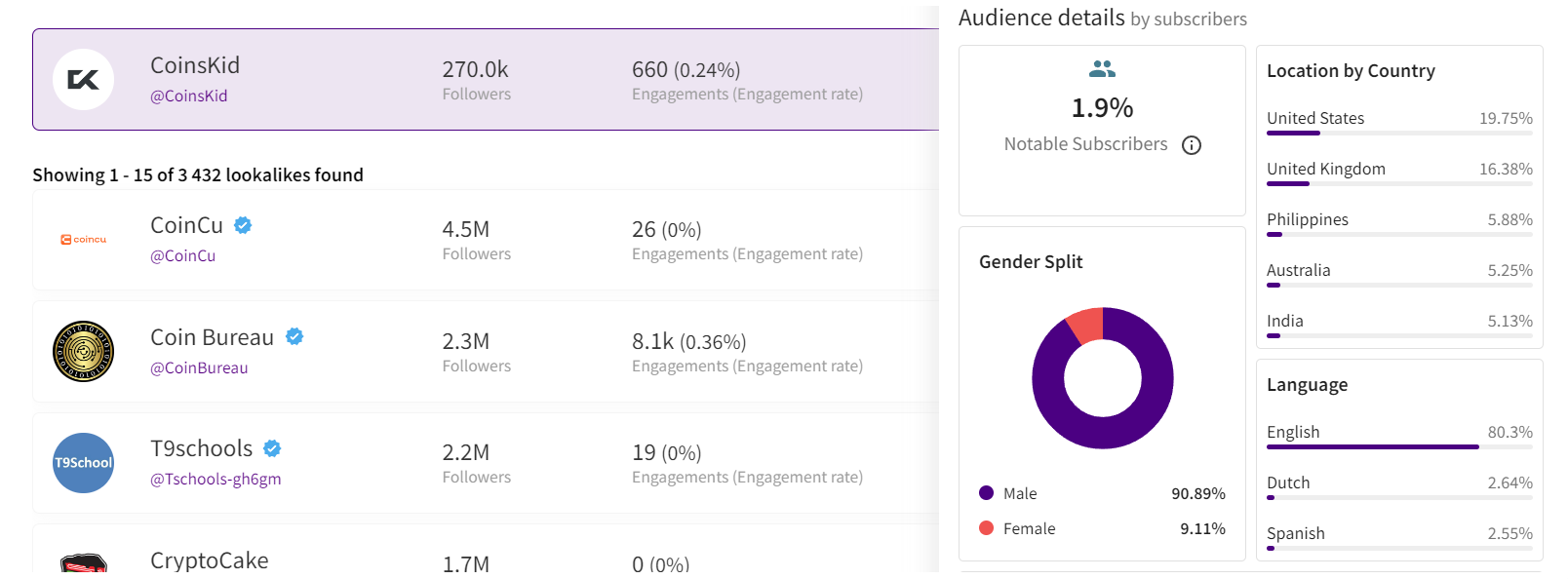 Example of statistics
Example of statistics
Wrapping up
These are the main factors to consider when selecting an influencer to promote your crypto product. Once you’ve launched the campaign, there are also some markers to show which creators did bring the authentic traffic and which used some tools to create the illusion of an active and engaged audience. While this may seem obvious, it’s still worth mentioning. After the video is posted, allow 5-7 days for it to accumulate a basic number of views, then check performance metrics such as views, clicks, click-through rate (CTR), signups, and conversion rate (CR) from clicks to signups.
If you overlooked some red flags when selecting crypto channels for your launch, you might find the following outcomes: channels with high views numbers and high CTRs, demonstrating the real interest of the audience, yet with remarkably low conversion rates. In the worst-case scenario, you might witness thousands of clicks resulting in zero to just a few signups. While this might suggest technical issues in other industries, in crypto campaigns it indicates that the creator engaged in the campaign not only bought fake views and comments but also link clicks. And this happens more often than you may realize.
Summing up, choosing the right crypto creator to promote your product is indeed a tricky job that requires a lot of resources to be put into the search process.

Author
Nadia Bubennikova, Head of agency at Famesters
Fintech
Central banks and the FinTech sector unite to change global payments space
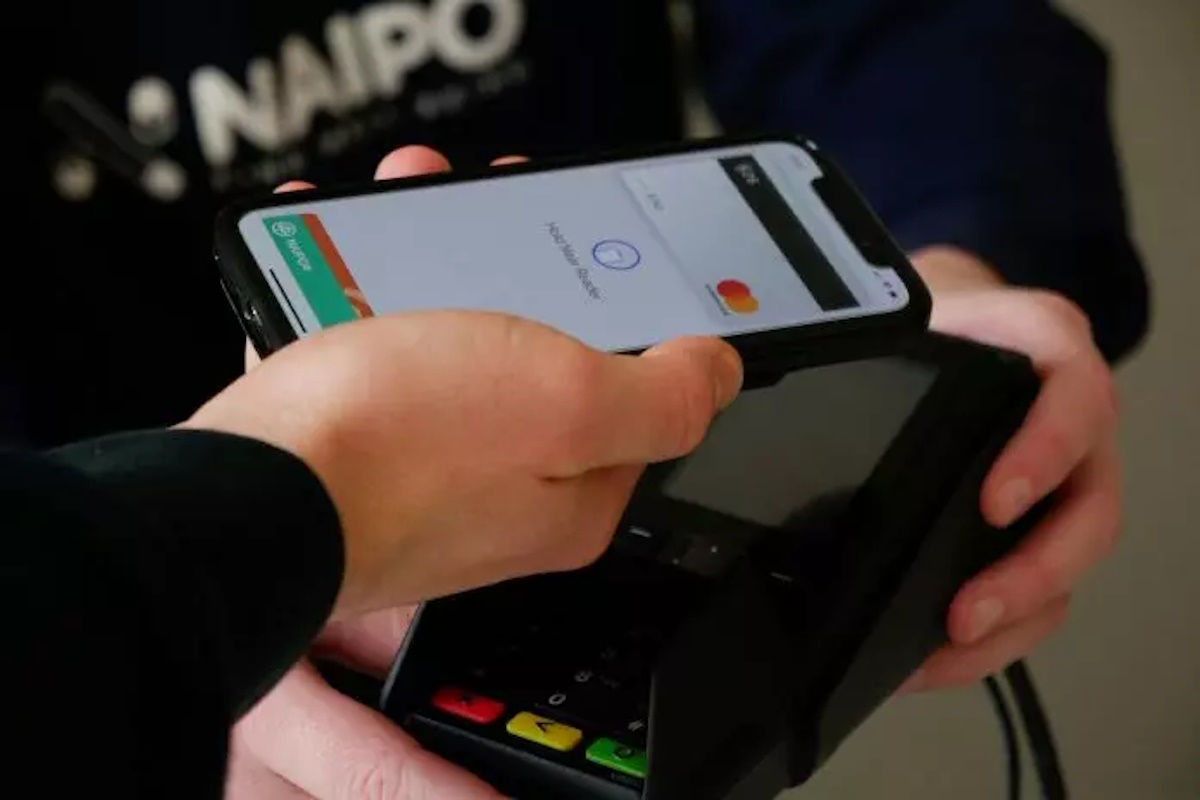
The BIS, along with seven leading central banks and a cohort of private financial firms, has embarked on an ambitious venture known as Project Agorá.
Named after the Greek word for “marketplace,” this initiative stands at the forefront of exploring the potential of tokenisation to significantly enhance the operational efficiency of the monetary system worldwide.
Central to this pioneering project are the Bank of France (on behalf of the Eurosystem), the Bank of Japan, the Bank of Korea, the Bank of Mexico, the Swiss National Bank, the Bank of England, and the Federal Reserve Bank of New York. These institutions have joined forces under the banner of Project Agorá, in partnership with an extensive assembly of private financial entities convened by the Institute of International Finance (IIF).
At the heart of Project Agorá is the pursuit of integrating tokenised commercial bank deposits with tokenised wholesale central bank money within a unified, public-private programmable financial platform. By harnessing the advanced capabilities of smart contracts and programmability, the project aspires to unlock new transactional possibilities that were previously infeasible or impractical, thereby fostering novel opportunities that could benefit businesses and consumers alike.
The collaborative effort seeks to address and surmount a variety of structural inefficiencies that currently plague cross-border payments. These challenges include disparate legal, regulatory, and technical standards; varying operating hours and time zones; and the heightened complexity associated with conducting financial integrity checks (such as anti-money laundering and customer verification procedures), which are often redundantly executed across multiple stages of a single transaction due to the involvement of several intermediaries.
As a beacon of experimental and exploratory projects, the BIS Innovation Hub is committed to delivering public goods to the global central banking community through initiatives like Project Agorá. In line with this mission, the BIS will soon issue a call for expressions of interest from private financial institutions eager to contribute to this ground-breaking project. The IIF will facilitate the involvement of private sector participants, extending an invitation to regulated financial institutions representing each of the seven aforementioned currencies to partake in this transformative endeavour.
Source: fintech.globa
The post Central banks and the FinTech sector unite to change global payments space appeared first on HIPTHER Alerts.
Fintech
TD Bank inks multi-year strategic partnership with Google Cloud
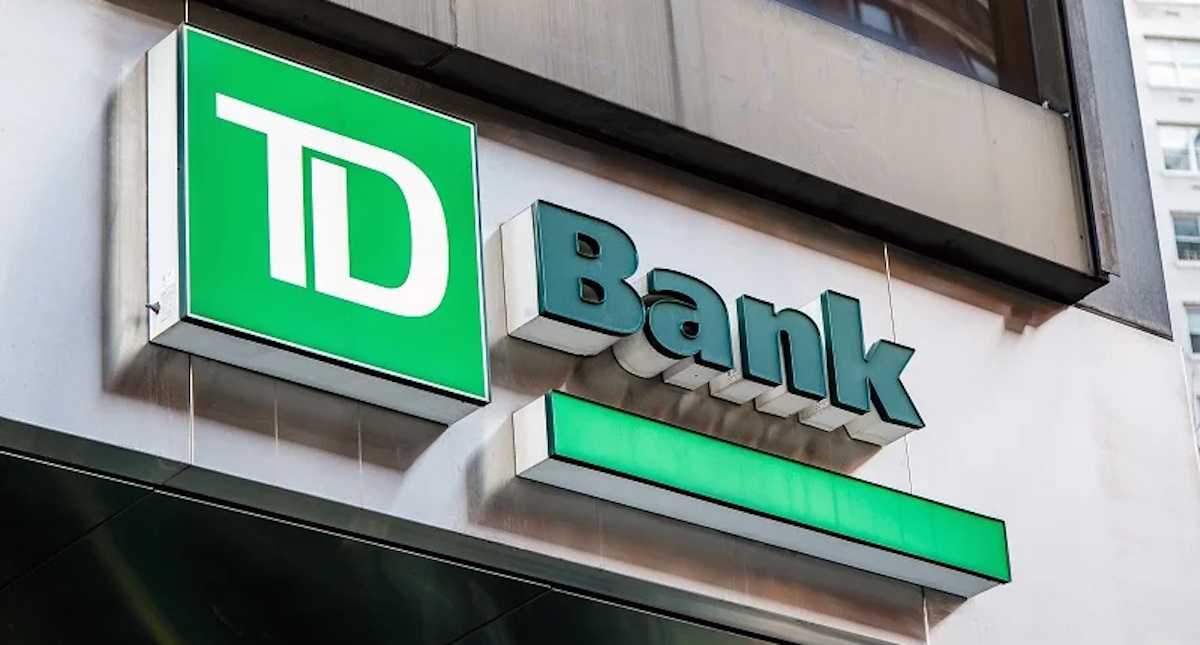
TD Bank has inked a multi-year deal with Google Cloud as it looks to streamline the development and deployment of new products and services.
The deal will see the Canadian banking group integrate the vendor’s cloud services into a wider portion of its technology solutions portfolio, a move which TD expects will enable it “to respond quickly to changing customer expectations by rolling out new features, updates, or entirely new financial products at an accelerated pace”.
This marks an expansion of the already established relationship between TD Bank and Google Cloud after the group previously adopted the vendor’s Google Kubernetes Engine (GKE) for TD Securities Automated Trading (TDSAT), the Chicago-based subsidiary of its investment banking unit, TD Securities.
TDSAT uses GKE for process automation and quantitative modelling across fixed income markets, resulting in the development of a “data-driven research platform” capable of processing large research workloads in trading.
Dan Bosman, SVP and CIO of TD Securities, claims the infrastructure has so far supported TDSAT with “compute-intensive quantitative analysis” while expanding the subsidiary’s “trading volumes and portfolio size”.
TD’s new partnership with Google Cloud will see the group attempt to replicate the same level of success across its entire portfolio.
Source: fintechfutures.com
The post TD Bank inks multi-year strategic partnership with Google Cloud appeared first on HIPTHER Alerts.
-
Latest News7 days ago
Trina Storage Recognized as Tier 1 Energy Storage Manufacturer by BNEF for Second Consecutive Quarter
-
Latest News7 days ago
EQT to acquire WSO2, a leading global provider of digital transformation technologies
-

 Latest News7 days ago
Latest News7 days agoGenome and Chilli Partners join forces to revolutionize iGaming affiliate payouts
-
Latest News7 days ago
Bank of Spain grants Amadeus’ Outpayce EMI licence
-
Latest News7 days ago
Newmark Reports First Quarter 2024 Financial Results
-
Latest News7 days ago
Lunar Poised for Nationwide Rollout in Sweden After Securing €24.1 Million in Funding
-
Latest News7 days ago
REALTY ONE GROUP CELEBRATES 19TH ANNIVERSARY WITH GLOBAL ‘ONE DAY’ OF VOLUNTEERING & GIVING BACK
-
Latest News7 days ago
BIZCLIK MEDIA LAUNCHES MAY EDITION OF FINTECH MAGAZINE





